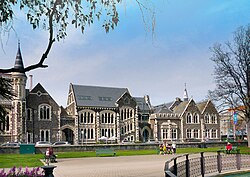The buildings are also listed in the Christchurch City Plan as heritage items. In the previous plan, 20 buildings were listed as Group 1 or 2, and three buildings were listed as Group 3. There are just two modern buildings on the site, with the Registry Additions built in 1957 and extended in 1967 and not listed under the old city plan, although it was proposed by the Christchurch City Council to include it in the listing with the historic registry building. [6]
Return of the university
In 2009 strong debate emerged over a proposal to use The Arts Centre Te Matatiki Toi Ora car park located off Hereford Street for the University of Canterbury's School of Music. Proponents valued the additional vibrancy that this would bring into the Cultural Precinct, and supported the university moving back to their original site. Opponents felt that the proposed building was out of scale with the existing Arts Centre and that the building design would detract from the heritage value. [7] [8] [9] Ultimately the proposal was abandoned after a successful campaign by Save our Arts Centre, a group led by Richard Sinke. [10]
In May 2017, the University of Canterbury returned to its former site. It opened two departments in the restored old Chemistry building – the classics and music school. Which now makes up the city campus of the university. Some 400 students transferred from the Ilam campus to the central city facility. [10] the building also houses the Teece Museum of Classical Antiquities which showcases the James Logie Memorial Collection, a collection of Greek, Roman, Egyptian and Near Eastern artefacts in New Zealand. [11]
Earthquakes and recovery
In the early hours of 4 September 2010, a major earthquake caused extensive damage throughout the Canterbury region. The Arts Centre Te Matatiki Toi Ora buildings were damaged – collapsing chimneys damaged the Great Hall, the Observatory Tower and the Clock Tower. The then Arts Centre director Ken Franklin commented that prior measures taken to reinforce the buildings may have prevented additional damage. [12] The buildings had been insured for NZ$95 million, and this was increased to NZ$120m in January 2011. [13]
The Arts Centre Te Matatiki Toi Ora was very badly damaged in the 22 February 2011 Christchurch earthquake, but no people were hurt at the centre. All historic buildings became inaccessible to the public and the entire complex was closed until the first restored and strengthened building, The Registry Building reopened in 2013. [13]
It was initially estimated the cost to repair The Arts Centre Te Matatiki Toi Ora would be NZ$100m. [13] [14] This was later revised to more than NZ$200m and estimated to take 15 years to accomplish. In July 2012, it was announced that André Lovatt had been secured as its new chief executive, tasking him with the restoration project; Lovatt started in October 2012. [15] Under Lovatt's guidance, the programme was accelerated although with the scope becoming better known, the costs escalated to NZ$290m making it one of the largest heritage restoration projects in the world. [16] [6]
The massive restoration programme immaculately restores and strengthens the heritage features of the centre's unique heritage buildings, while fitting them out with the latest modern facilities. With more than two-thirds of the centre open again, it is home to museums, art galleries, boutique eateries and retailers, offices, arts and cultural events, a weekly market and venues for hire.
While a significant amount of the restoration has been paid for, there is still a substantial shortfall in funds to complete it and the charitable trust is actively fundraising with the next stage to include the $10m restoration of the Observatory Tower and the restoration of the Physics, Biology and Engineering buildings. The Physics and Biology buildings will become home to a boutique hotel. The Observatory Hotel opened in the restored Townsend Observatory in 2022. [17]
The first buildings to reopen after the earthquake were Registry, Registry Additions and The Gym with Registry reopening in July 2013. [18] The Great Hall opened in June 2016.
Christchurch Arts Centre, 2020
English stained glass window, 2019
Archways on outside of building, 2019
English hands and faces on window surrounds, 2020
Inside the Great Hall 2016
Sculpture in the inner court 2019










